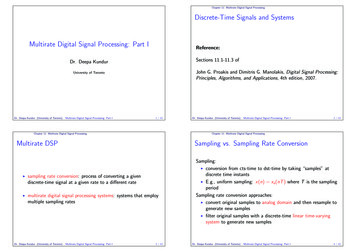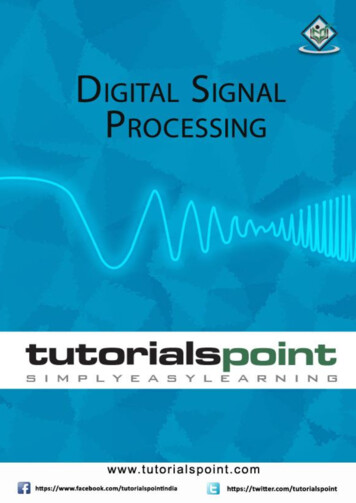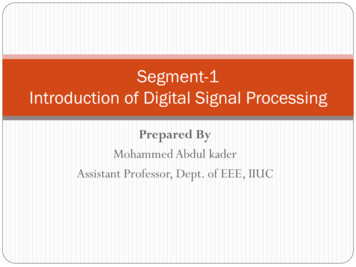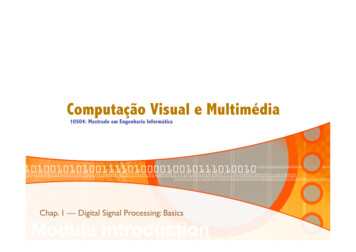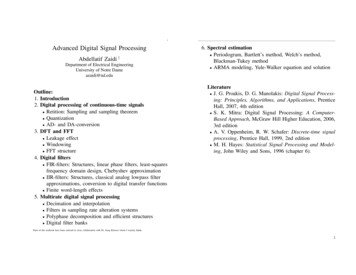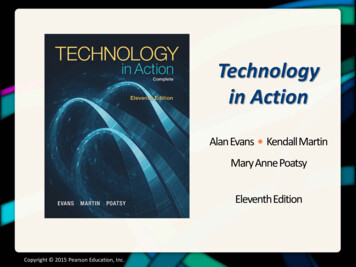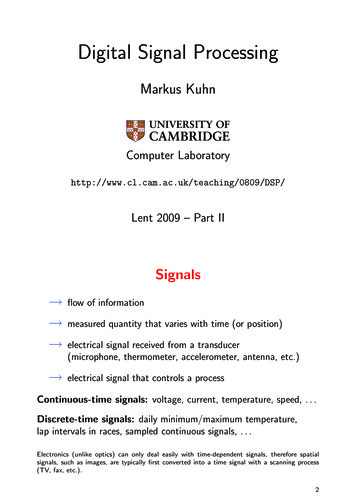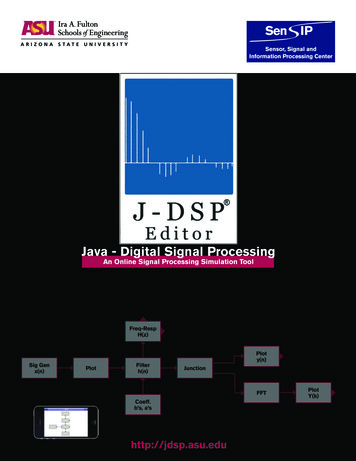
Transcription
SenIPSensor, Signal andInformation Processing CenterJava - Digital Signal ProcessingAn Online Signal Processing Simulation ToolFreq-RespH(z)Sig s, a’shttp://jdsp.asu.eduPlotY(k)
About the J-DSP EditorJava-DSP (J-DSP) is an educational software package for online simulations and web-basedcomputer laboratories. J-DSP is based on an object-oriented visual programming environmentthat enables students to establish and run DSP simulations on the Internet. This universallyaccessible tool is based on an intuitive “block diagram” programming approach. J-DSP hasbeen developed specifically for education; several functions have been inspired by interactionswith students to explain concepts that were not evident with blackboard-type explanations. Thefunctions that J-DSP supports are suitable for basic DSP tutoring as well as for demonstratingadvanced algorithms. Basic functions include signal generators, arithmetic functions, convolution,filtering, the FFT, impulse and frequency response plots, etc. Advanced functions includestatistical and multirate DSP, fixed-point and PCM quantization blocks, select MPEG-Layer 3functions, and hidden Markov model (HMM) estimation. More on J-DSP functions and theirassessment can be found in: A. Spanias, V. Atti, “Interactive online undergraduate laboratoriesusing “J-DSP,” IEEE Transactions on Education, vol. 48, no. 4, pp. 735- 749, Nov. 2005.Visualize DSPconceptsJ-DSP is universally and freely accessibleJ-DSP is an on-line graphical DSP simulator written as a Java applet.Users can obtain graphical or numerical results at any point of thesimulation.Provides a simple graphical and user-friendly interface.J-DSP has won national awards and ranked as one of the top 3non-commercial education software resources by NEEDS in 2003.J-DSP is also being used in sensor networks research.J-DSP is used in earth systems and geology.A J-DSP arts and media functions suite is being developed.J-DSP interfaces with DSP hardware have been established.A functional MP3 decoder in J-DSP has been tested.Ion-channel models in J-DSP for sensor applications have beenformed.1
J-DSP Functionality and ApplicationsBasic FunctionsFundamental DSP Functions(FFT, IFFT, Windowing etc)Basic Arithmetic FunctionalityMulti-rate DSPPole-Zero z-domain diagramsFrequency ResponseFreq-RespH(z)Visualization BlocksDigital FilteringFIR/IIR Filter DesignSpectral EstimationSig Genx(n)PlotFilterh(n)3D AnimationsSignal to noise ratioPloty(n)JunctionFFTCoeff.b’s, a’sPlotY(k)SpectrogramVisual impulse response designQuantization functionsParametric methodsAdvanced FunctionsAnalog and Digital CommunicationsControl SystemsImage and 2D Signal ProcessingSpeech Analysis and SynthesisTime/Frequency RepresentationsHidden Markov Model (HMM) TrainingPerceptual Audio Coding TechniquesGenomic Signal ProcessingAdaptive Signal ProcessingBeamforming Applicationshttp://jdsp.asu.edu2
J-DSP and Sensor NetworksRemote sensing enabled by J-DSPSpectralEnvelopeJava InterpreterJava Interfaceswith Tiny OSusing nesClanguageRemote sensinghardware set-upAR EstimatorSensor moteinterfacePeriodogramApplicationsEnvironmental MonitoringAcoustic MonitoringSecuritySource LocalizationTrackingBiological ApplicationsCollaborativeReal-TimeSensor SignalProcessingEnabledby J-DSP3Scope
Learning the basics of MP3 compression using J-DSPCritical band analysisMP3 DecoderTonal and noise makingexperimentsMPEG-1 psychoacousticsmodel-1 implementationMP3 bit streamJ-DSP piano player and phone dialing functionsJ-DSP can be used to introducesignals and systems in freshmanand senior high school classes.Tone-generatorsMIDI encoderDTMF encoderEcho and Reverberation EffectsJ-DSP Interface with DSP BoardsReal-time experimentswith J-DSPGUI enabled programmingof DSP chipsInterface with Texas InstrumentsboardsSound processing andcompression with InverseFFTScope4
J-DSP External Software InterfacesSeamlessly embed J-DSP Simulations in Web Content using J-DSP ScriptsGenerate MathScriptTM code from J-DSP and integrate with LabVIEWExport J-DSP functions as a MATLAB scriptJ-DSPMATLABTMHTMLLabVIEWTMExport J-DSP simulation in MATLAB.Copy and paste into MATLAB window.Extend functionality in Matlab as needed.Export J-DSP simulation in HTML.Copy and paste script into an HTML file.Add your own educational contentDeliver to students.Export J-DSP simulation in MathScriptTM.Copy and paste into an m-file.Supply the file path to LabVIEW model.Run the model and openJDSP Labview Interface to visualize theblock diagram.MATLAB and LabVIEW are registered trademarks of The Mathworks and National Instruments, respectively.Multi-Disciplinary Applications of yze the DNA sequences using numerical mapping, FFT powerspectrum, and correlations.Visualize the 2π/3 periodicityEarth-SystemsStandardizedETP SignalA collaborativeproject betweenASU, Johns HopkinsUniversity andPurdue University.SpectrogramMultiple ProlateTaper SpectrumFiltered Signal P-BandTanner Filter5Functions tailored toperform analysis andvisualization of earthsystem signals.Geophysicists areintroduced to basicDSP conceptsand get hands-onexperience withanalysis of EarthSystems data.
A DSP book with J-DSP simulations and experimentsDigital Signal ProcessingAn Interactive Approachby Andreas SpaniasThe book provides theoretical treatments and Java simulations of the followingtopics:Extensive review of continuous-time signals and systems concepts; Java simulation ofsampling.Introduction to discrete-time systems and applications; J-DSP experiments on digital filters.DTFT, FFT, and z-transforms; pole zero diagrams and FFT spectra with Java.Filter design; Kaiser, Parks-McClellan, Butterworth/Chebyshev; Interactive J-DSP FIR/IIRdesign.The Digital Signal Processing bookcan be found at:http://www.lulu.com/content/2581497ISBN 978-1-4243-2524-5Multirate systems, downsampling / upsampling, QMF subband coding, A/D - concepts.Discrete-time random signals; correlation; channel estimation. J-DSP and spectral estimation.Adaptive filters; LMS and RLS, Noise Cancellation. LMS convergence simulation with J-DSP.Quantization effects, fixed-point processing, PCM, roundoff errors, J-DSP Quantization functions.Speech processing algorithms. Linear prediction with Java. LPC and CELP standards.Audio coding, Filter banks, the MP3 algorithm; Step-by-step Java visualization of Psychoacoustics.Computer exercises in J-DSP complement the theory and reinforce concept learning. A chapter-by-chaptercomprehensive bibliography is provided with more than 100 references to additional sources of information toexplore topics in greater depth.The textbook includes all the appropriate contents and topics for undergraduate or graduate courses in digitalsignal processing.J-DSP AssessmentThe assessment results were collected from students of EEE 407 (DSP) class.General Assessment:Subjective opinion about J-DSP was collected.95% liked the concept of Internet-based simulations.70% responded that it took them less than 30 minutes to learn howto use J-DSP.85.5% are likely to consider using J-DSP to construct their owneducational simulations.Concept-Specific Assessment:Laboratory evaluations, both before using J-DSP (pre-lab) and after(post-lab), were carried out.87% agreed that with the J-DSP filter design exercise theyunderstood which window is suitable for sharp transitions.88% understood better the signal symmetries in the FFT spectrausing of J-DSP visualization.91% reported that with J-DSP they understood the relation betweenthe Pole-Zero locations and the frequency response.http://jdsp.asu.eduLab – 1: Difference Equations and Z-TransformLab – 2: Pole-Zero Plots and Frequency ResponsesLab – 3: FIR and IIR Filter DesignLab – 4: The Fast Fourier Transform (FFT)Lab – 5: Multi-rate Signal Processing and QMF BanksJ-DSP in the classroom.6
NSF Multi-University Project on J-DSP Software DevelopmentNSF CCLI Phase 2:Development and Dissemination of On-Line Laboratories in Networks, Probability Theory, SignalsAnd Systems, And Multimedia ComputingPI : Andreas Spanias (ASU)Co-PIs: A. Papandreou-Suppappola (ASU), C. Tepedelenlioglu (ASU), J. Zhang (ASU),F. Bodreaux-Bartels (University of Rhode Island),M. Stiber (University of Washington-Bothell),T. Kasparis (University of Central Florida), andP. Loizou (UT Dallas)NSF awardnumber 0443137CCLI-EMDUniversity ofWashington - Bothell(UWB)University ofTexas at Dallas(UTD)Arizona StateUniversityUniversity ofRhode Island(URI)University ofCentral Florida(UCF)The CCLI-EMD collaborative effort involves five universities, namely, Arizona State University (ASU), the Universityof Washington-Bothell (UWB), the University of Texas at Dallas (UTD), the University of Rhode Island (URI), and theUniversity of Central Florida (UCF). This project addresses significant educational technology innovations and softwareextensions that enable the online software Java-DSP (J-DSP) to be used in three courses at these five universities.The Collaborative NSF EMD involves:Educational innovation achieved by generating a large volume of new Java software that upgrades considerably theJ-DSP graphical user interface (GUI).A software development task that extends the mathematical and signal processing functionality of J-DSP so that itcan support online computer laboratories in four courses. This task engages five faculty and several students.A dissemination and assessment plan that involves five universities in order to test and provide feedback on the newJ-DSP GUI and all exercises and content.A comprehensive pilot test of a new multi-site laboratory concept that allows students in the five universities to runreal-time distributed online simulations.7
NSF TUES Phase 3:Collaborative Research: Design and Dissemination ofMultidisciplinary Digital Signal Processing Software and ContentJ-DSP Infrastructure Extensions toArts, Power, Biology, GenomicsJ-DSP BookJ-DSP CDJ-DSP in Earth andGeology SystemsJ-DSP in PVAMUDSP CoursesJ-DSP in MusicSynthesisOnline Visual DSP ProgrammingJ-DSP in PVAMUDSP CoursesJ-DSP in Media ComputingNSF awardnumber 0817596J-DSP in Signal, Imageand Biomedical ProcessingThe TUES (CCLI) Phase 3 proposal builds on several products and outcomes of two previous Phase 2 CCLI EMDs and revolvesaround our online software technology J-DSP. This Phase 3 proposed comprehensive project expands the scope of J-DSP beyondElectrical Engineering to other fields associate with multidisciplinary applications that are central to the nations’ security and economicwelfare. Our first multidisciplinary activity with Johns Hopkins University and two other partners is to create a J-DSP/Earth Systemsversion which will be customized for earth system sciences and geology, and will also embrace issues of sustainability. The softwareand associated module will be used in classes at JHU. Our second multidisciplinary activity has to do with extensions of J-DSP to artsand media (with the ASU AME) providing artists with creative web-based DSP software tools and embedding and assessing J-DSPmodules in AME courses. A companion activity will embed J-DSP modules in a music synthesis course at the Rose-Hulman Instituteof Technology (RHIT). Our third inter-technology activity provides J-DSP and J-DSP-C modules for power engineering courses andembraces issues of renewable energy (with ASU Power Systems). A series of equally important activities with our partners targetinterdisciplinary and inter-technology areas including: interpreting biological signals from ion-channel sensors with J-DSP (with theArizona Institute of Nanoelectronics), using J-DSP to expose students to the importance of signal analysis in sensing and genomics(with the ASU SenSIP; http://sensip.asu.edu), embedding J-DSP in FPGA systems courses (with UNM), embedding J-DSP incomputing and programming applications (UWB), and embedding J-DSP in DSP courses (with PVAMU).http://jdsp.asu.edu8
An Interactive Signal Processing Tool for iOSand Android devicesThe ASU i-JDSP app has been selected by theNEEDS panel as the Premier Award winnerfor 2012. The Premier Award is sponsored byJohn Wiley & Sons, Microsoft Research, theMathWorks, and TechSmith.i-JDSPi-JDSP is an interactive iPhone/iPad signal processingtool based on JDSP. It is implemented in Objective-Cand C as a native Cocoa Touch application thatcan be run on any iOS device. It provides a verycompelling multi-touch programming experience. Allsimulations can be visually established by forminginteractive block diagrams throughmulti-touch and drag-and-drop.A-JDSP is an interactiveAndroid application based on JDSP.It can run on Android phones and tablets. Interfacesfor education and research are being designed. Aninterface with hardware will be used for monitoringand control of a sensor network.All system and network simulations can be visuallyestablished through a drag-and-drop interface.iJDSP is now available for download inthe iTunes App store for free!On Andriod App storeearly 2013.Key FeaturesGraphical programming experience.Easy to use multi-touch and drag-and-drop.Access through online app store.Small footprint, efficiency and scalability.Wireless interface to sensor network hardware.Interface to real-time DSP board.z transform and pole-zero dashboard.Functions for outreach.Runs on iPhone, iPad and iPod touch.Coming soon health monitoring functions.9A-JDSPi-JDSP and A-JDSP are supported in part by NSF award0817596, the SenSIP center and Sprint Communications.Planned FunctionsSignal GeneratorDigital FiltersFilter DesignFrequency ResponseFast Fourier Transform (FFT)Magnitude and Phase PlotsPole-zero PlotAudio SpectrogramSpeech and Audio CodingDemosSenIPSensor, Signal andInformation Processing Center
PublicationsA. Clausen, A. Spanias, A. Xavier, M. Tampi, “A Java signal analysistool for signal processing experiments,” Proc. IEEE ICASSP, vol.3,no. pp.1849-1852 vol.3, Seattle, May 1998.A. Spanias, et al, “Development of a Web-based Signal and SpeechProcessing Laboratory for Distance Learning,” ASEE Computers inEducation Journal, pp. 21-26, Vol. X, No.2, April-June 2000.T. Thrasyvoulou, K. Tsakalis, A. Spanias, “J-DSP-C, a controlsystems simulation environment: labs and assessment,” Proc. IEEEFIE 2003, pp. T4E 11- T4E 16, Denver, Nov. 2003.A. Spanias, T. Thrasyvoulou, Yu Song, C. Panayiotou, “Using J-DSPto introduce communications and multimedia technologies tohigh schools,” Proc. IEEE FIE 2003, vol. 2, pp. F3A 22- F3A 27,Denver, Nov. 2003.A. Spanias, V. Atti, T. Thrasyvoulou, M. Yasin, M. Zaman, T. Duman,L. Karam, A. Papandreou, K. Tsakalis, “On-line laboratories forspeech and image processing and for communication systemsusing J-DSP,” Proc. IEEE DSP and SPE Workshop, pp. 174- 179,Pine Mountain, Oct. 2002.A. Spanias, C. Panayiotou, T. Thrasyvoulou, V. Atti, “Java-DSPInterface with MATLAB and its Use in Engineering Education,”Proc. of ASEE-2004 Conference, Salt Lake City, Utah, June 2004.A. Spanias, et al., “Teaching Genomics and Bioinformatics toUndergraduates using J-DSP,” Proc. of ASEE-2004 Conference,Salt Lake City, June 2004.Yu Song, A. Spanias, V. Atti, V. Berisha, “Interactive Java modulesfor the MPEG-1 psychoacoustic model [audio coding teachingapplications],” Proc. IEEE ICASSP, vol.5, pp. v/581- v/584, Vol. 5,Philadelphia, March 2005.A. Spanias, V. Atti, “The JAVA-DSP (J-DSP) PROJECT – From thePrototype to the Full Implementation and Dissemination,” Proc. of2005 ASEE -2005 Conference, Portland, June 12-15, 2005.A. Spanias, R. Chilumula, C. Huang, “Collaborative Signals andSystems Laboratories at ASU, UWB, UCF, UTD, and URI,” Proc.IEEE FIE 2006, San Diego, October 2006.A. Spanias, V. Berisha, H. Kwon, C. Huang, A. Natarajan, R.Ferzli, “Using the Java-DSP Real-Time Hardware Interface InUndergraduate Classes,” Session M4D, Proc. IEEE FIE-2006, SanDiego, October 2006.A. Spanias, Jayaraman J. Thiagarajan, Karthikeyan NatesanRamamurthy, “Using the J-DSP Online Export Capabilities toPerform Undergraduate DSP Labs with LabVIEW,” Proc. ASEE2007,, June 2007.Spanias, A.; Hinnov, L.; Stiber, M.; Akujuobi, C.; Pattichis, M.;Pattichis, C.; Doering, E.; Ramamurthy, K.; Mehta, S.;, “The JavaDSP Phase 3 project: An interdisciplinary multiuniversity effort,”Proc. of ASEE-2009 Conference, Austin, Texas, June 2009.Ramamurthy, K.; Spanias, A.; Hinnov, L.; Akujuobi, C.; Stiber, M.;Pattichis, M.; Doering, E.; Pattichis, C.; Thornburg, H.; PapandreouSuppappola, A.; Spanias, P.; Ayyanar, R.; Campana, E.; Haag, S.;,“WIP - Collaborative multidisciplinary J-DSP software project,”IEEE FIE ‘09. 1-2, Oct. 2009.Mehta, S.; Thiagarajan, J.J.; Spanias, P.; Ramamurthy, K.; Santucci,R.; Spanias, A.; Haag, S.; Banavar, M.;, “An interactive learningenvironment for DSP,” Proc. of ASEE-2010 Conference, Louisville,Kentucky, June 2010.Santucci, R.; Gupta, T.; Shah, M.; Spanias, A.;, “Advanced functionsof Java-DSP for use in electrical and computer engineeringcourses,” Proc. of ASEE-2010 Conference, Louisville, Kentucky,June 2010.Shah, M.; Wichern, G.; Spanias, A.; Thornburg, H.; , “Audio contentbased feature extraction algorithms using J-DSP for arts, mediaand engineering courses,” IEEE FIE 2010, Oct. 27-30, 2010.Mehta, S.M.; Spanias, A.; Thiagarajan, J.J.; , “Work in progress —An interactive web-based quiz that uses the java-DSP editor toenhance student learning experience,” IEEE FIE 2010, pp.T2G-1T2G-2, Oct. 27-30, 2010.Huang, C.; Thiagarajan, J. J.; Spanias, A.; Pattichis, C.;, “A Java-DSPinterface for analysis of the MP3 algorithm,” Proc. of the IEEEDSP/SPE Workshop, pp.168-173, 4-7 Jan. 2011.Ramamurthy, K. N.; Spanias, A.; Hinnov, A.; , “J-DSP/ESElaboratories for analyzing climate change,” Proc. of ASEE-2011Conference, Vancouver, June 2011.Thiagarajan, J. J.; Spanias, A.; Ayyanar, R. , “Designing onlinelaboratories for power electronics courses using J-DSP software,”Proc. of ASEE-2011 Conference, Vancouver, June 2011.Santucci, B.; Spanias, A.; , “Use of Java-DSP to DemonstratePower Amplifier Linearization Techniques,” Proc. of ASEE-2011Conference, Vancouver, BC, Canada, June 2011.Liu, J.; Thiagarajan, J. J.; Spanias, A.; Ramamurthy, K. N.; Hu,S.; Banavar, M. K. , “iPhone/iPad-Based Interactive Laboratoryfor Signal Processing in Mobile Devices,” Proc. of ASEE-2011Conference, Vancouver, June 2011.Liu, J.; Spanias, A.; Banavar, M. K.; Thiagarajan, J. J.; Ramamurthy, K.N.; Hu, S.; Xue, S., Work in Progress - Interactive signal processinglabs and simulations on iOS devices,” IEEE FIE 2011, South Dakota,October 2011.Hinnov, L.; Ramamurthy, K. N.; Spanias, A.;, “Work in Progress - TheJDSP/ESE software for analyzing earth systems signals,” IEEEFIE 2011, South Dakota, October 2011.Ranganath S., Thiagarajan J., Ramamurthy K.,Hu S., BanavarM., Spanias A., “WIP: Signal Analysis Laboratories using AndroidDevices,” Proc. IEEE FIE 2012, Seattle, October 2012.J-DSPAndreas Spanias is the director of the J-DSP GUI design and softwaredevelopment team and the PI on the three NSF projects that supportedportions of this project. Several ASU graduate students helped withthe development of J-DSP functions including V. Atti, C. Panayiotou, T.Thrassyvoulou, Y. Song, A. Constantinou, A. Clausen, H. Krishnamoorthi,C. Huang, J. Thiagarajan, K. Ramamurthy, A. Natarajan, M. Zaman, K.Ahmed, F. Bizuneh, T. Painter, H. Kwon, M. Banavar, S. Misra, V. Berisha,R. Chilumula, M. Tampi, M. Shah, S. Mehta, G. Stylianou, S. Ranganath,X. Zhang, S. Zhang, D. Rajan, B. Santucci, P. Sattigeri, J. Liu, S. Hu, G.Kalyanasundaram. Certain specialized functions were designed byconsulting with several colleagues including: Antonia PapandreouSuppappola, Michael Stiber, Tolga Duman, Linda Hinnov, Lina Karam, andKostas Tsakalis. J-DSP concept by A. Spanias.http://jdsp.asu.eduJ-DSP development team.10
J-DSPSignalRemote zationCommunictionsJAVABecome a test site for J-DSPHost a mirror site at your university.Include J-DSP in your simulations and class notes.Use J-DSP in research and health monitoring.Collaborate with ASU and embed J-DSP in your dissemination plans.Use the new i-JDSP and A-JDSP with iPhone/iPad and Android tablets.Use i-JDSP for outreach.Contact InformationDr. Andreas SpaniasProfessor, Director of the SenSIP ConsortiumSchool of Electrical, Computer, and Energy EngineeringIra A. Fulton Schools of EngineeringBox 5706, GWC 411Arizona State UniversityTempe, AZ 85287-5706, USAEmail: spanias@asu.eduPhone: (480) 965-1837i-JDSP for thmsGeneratorsJ-DSP was sponsored in part by the National Science Foundation (NSF) EMD, TUES and CRCD awards0817596, 0443137 and 0417604. Any opinions, findings and conclusions or recommendations expressed inthis material are those of the author(s) and do not necessarily reflect those of the National Science Foundation.J-DSP WorkshopsNovember 2012, DSP Tools on Android devices, ASU Main Campus, Tempe, AZJuly 23, 2012, University of Cyprus, Cyprus.March 9, 2012, Signal Analysis on the iPhone and iPad, ASU Main Campus, Tempe, AZJanuary 27, 2012, J-DSP/ESE Tools for Earth Systems and Sustainability, ASU Main Campus, Tempe, AZJanuary 4, 2011, IEEE DSP-SPE Workshop, Sedona AZMarch 14, 2010, Joint Section Meeting, Geological Society of America (GSA) , Baltimore, MarylandOctober 18, 2009, IEEE Frontiers in Education (FIE) Conference, San Antonio, TexasJune 24, 2009, Arizona State University main campus, Tempe, ArizonaWorkshops will be scheduled in Houston, Indianapolis, London, New York city, Orlando, Cyprus.AwardsOctober 2012: The ASU iJDSP app for the iPhone/iPad was selected bythe NEEDS panel as the Premier Award winner for 2012. The Premier Award issponsored by John Wiley & Sons, Microsoft Research, the MathWorks, and TechSmith.Feb 2007: J-DSP Team Award: For developing the outstanding non-commercialsoftware J-DSP for Education and Research, IEEE Phoenix section.Oct 2003: J-DSP voted as one of the top three learning resources for 2003 by theNational Engineering Education Delivery System (NEEDS).http://jdsp.asu.edu
1 J-DSP is universally and freely accessible Q J-DSP is an on-line graphical DSP simulator written as a Java applet. Q Users can obtain graphical or numerical results at any point of the simulation. Q Provides a simple graphical and user-friendly interface. Q J-DSP has won national awards and ranked as one of the top 3 non-commercial education software resources by NEEDS in 2003.
